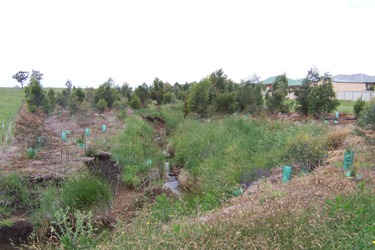
Fish friendly councils top tip 5
5. Protect and manage buffer areas
Native trees, shrubs or grasses on river banks and areas adjacent to wetlands are vital. This riparian vegetation buffer helps stabilise riverbanks and reduce erosion and subsequent siltation. The vegetation contributes food for fish such as organic matter and insects. The buffer strip will also help filter nutrients and sediments from run-off, reducing the likelihood of algal blooms. Well-developed riparian vegetation also provides a greater diversity of in-stream habitat for fish and shade for the creek. These areas help protect biodiversity by providing wildlife corridors that enable animals and birds to move freely. Buffer areas also provide open space and community recreationopportunities. Setbacks of 50-100 metres for key fish habitat are recommended to ensure the water quality and habitat are adequately protected from adjoining developments.
Council can ...
- recognise the value of riparian and aquatic habitat and ensure new developments have appropriate setbacks
- manage and maintain existing buffer areas for community recreation and river health.
Case study: Somerset Park, Orange, Orange City Council

Somerset Park. Image Orange City Council
Somerset Park provides a much needed passive open space for a range of recreational pursuits in an expanding urban landscape. The park also protects an un-named watercourse that collects urban stormwater runoff from the north western parts of the city. Recognising the poor health of the Park and the impact willows were having, Orange City Council initiated a riparian rehabilitation and revegetation project over 1.3 km of the watercourse. More...
See also
- 1. Find out about your local fish populations
- 2. Help protect key fish habitat in Council planning processes
- 3. Ensure council infrastructure is fish friendly
- 4. Treat stormwater prior to discharge
- 6. Maintain and enhance public reserves for river health
- 7. Collaborate with your neighbouring councils
- 8. Support local groups working on fish friendly projects (for example: Rivercare, Landcare, Indigenous groups, Fishing clubs)
- 9. Educate your local community about fish and river health
- 10. Promote your fish friendly work to the wider community

